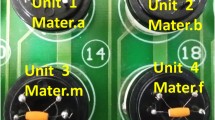Abstract
Sewage treatment works are one of the major sources that cause atmospheric odour pollution. The increase in the number of complaints about odour nuisance is due to the increase in environmental concerns. Unfortunately, the legislation on odour nuisance from sewage treatment works is very limited. In order to determine suitable thresholds on which to base legal standards, reliable and efficient odour measurement methods need to be defined. A chemical sensor array was developed for the purpose of measuring wastewater odour. This paper describes the development of the chemical sensor system which is specifically tuned to odours of wastewater origin and which can give an electronic measure of the wastewater odours. Odour emissions from a wastewater treatment facility were detected by using a quartz crystal microbalance (QCM) sensor array. The array consists of nine sensor elements, which were coated with different materials. In this paper, the usage of these novel instruments in the water industry was shown.
Similar content being viewed by others
References
Ameer, Q., & Adeloju, S. B. (2005). Polypyrrole-based electronic noses for environmental and industrial analysis. Sensors and Actuators B, 106, 541–552.
Bartlett, P. N., & Gardner, J. W. (1991, August). Odour sensors for an electronic nose (Paper presented at the Proc. NATO Advanced Research Workshop Sensors and Sensory Systems for an Electronic Nose, Iceland).
Bastos, A. C., & Magan, N. (2006). Potential of a an electronic nose for the early detection and differentiation between Streptomyces in potable water. Sensors and Actuators B-Chemical, 116, 151–155.
Bhattacharyya, N., Seth, S., Tudu, B., Tamuly, P., Jana, A., Ghosh, D., Bandyopadhyay, R., & Bhuyan, M. (2007). Monitoring of black tea fermentation process using electronic nose. Journal of Food Engineering, 80, 1146–1156.
Bourgeois, W., Romain, A. C., Nicolas, J., & Stuetz, R. M. (2003). The use of sensor arrays for environmental monitoring: interests and limitations. Journal of Environmental Monitoring, 5, 852–860.
Bruno, P., Caselli, M., de Gennaro, G., Solito, M., & Tutino, M. (2007). Monitoring of odor compounds produced by solid waste treatment plants with diffusive samplers. Waste Management, 27, 539–544.
Fenner, R. A., & Stuetz, R. M. (1999). The application of electronic nose technology to environmental monitoring of water and wastewater treatment activities. Water Environment Research, 71, 282–289.
Frechen, F. B. (1994). Odor emissions of waste-water treatment plants—recent German experiences. Water Science and Technology, 30, 35–46.
Fuchs, S., Strobel, P., Siadat, M., & Lumbreras, M. (2007). Evaluation of unpleasant odor with a portable electronic nose. Materials Science and Engineering, (in press) DOI 10.1016/j.msec.2007.10.066
Gardner, J. W., & Bartlett, P. N. (1994). A brief history of electronic noses. Sensors and Actuators, 18–19, 211–220.
Gostelow, P., Parsons, S. A., & Stuetz, R. M. (2001). Odour measurements for sewage treatment works. Water Research, 35, 579–597.
Haas, T., Lammers, P. S., Diekmann, B., Horner, G., & Boeker, P. (2007). A method for online measurement of odour with a chemosensor system. Sensors and Actuators B: Chemical, 2481–2484 DOI 10.1016/j.snb.2007.11.041.
Nake, A., Dubreuil, B., Raynaud, C., & Talou, T. (2005). Outdoor in situ monitoring of volatile emissions from wastewater treatment plants with two portable technologies of electronic noses. Sensors and Actuators B, 106(2005), 36–39.
Nimmermark, S. (2001). Use of electronic noses for detection of odour from animal production facilities: A review (Paper presented at the 1st IWA International Conference on Odour and VOCs, UNSW, Sydney)
Onkal-Engin, G., Demir, I., & Engin, S. N. (2005). Determination of the relationship between sewage odour and BOD by neural networks. Environmental Modeling & Software, 20, 843–850.
Qu, G., Feddes, J. J. R., Armstrong, W. W., Coleman, R. N., & Leonard, J. J. (2000). Measuring odour concentrations with an electronic nose. Transactions of the ASAE, 44, 1807–1812.
Segala, C., Poizeau, D., & Mace, J. M. (2003). Odors and health: a descriptive epidemiological study around a wastewater treatment plant. Revue D Epidemiologie et de Sante Publique, 51, 201–214.
Stuetz, R. M., Fenner, R. A., & Engin, G. (1999). Characterisation of wastewater using an electronic NOSE. Water Research, 33(2), 442–452.
Author information
Authors and Affiliations
Corresponding author
Rights and permissions
About this article
Cite this article
Ziya Öztürk, Z., Tasaltin, C., Engin, G.Ö. et al. Evaluation of a fast wastewater odour characterisation procedure using a chemical sensor array. Environ Monit Assess 151, 369–375 (2009). https://doi.org/10.1007/s10661-008-0278-6
Received:
Accepted:
Published:
Issue Date:
DOI: https://doi.org/10.1007/s10661-008-0278-6




